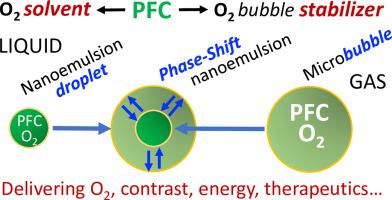Advances in Colloid and Interface Science ( IF 15.9 ) Pub Date : 2021-05-01 , DOI: 10.1016/j.cis.2021.102407 Marie Pierre Krafft 1 , Jean G Riess 2

|
After the protocol-related indecisive clinical trial of Oxygent, a perfluorooctylbromide/phospholipid nanoemulsion, in cardiac surgery, that often unduly assigned the observed untoward effects to the product, the development of perfluorocarbon (PFC)-based O2 nanoemulsions (“blood substitutes”) has come to a low. Yet, significant further demonstrations of PFC O2-delivery efficacy have continuously been reported, such as relief of hypoxia after myocardial infarction or stroke; protection of vital organs during surgery; potentiation of O2-dependent cancer therapies, including radio-, photodynamic-, chemo- and immunotherapies; regeneration of damaged nerve, bone or cartilage; preservation of organ grafts destined for transplantation; and control of gas supply in tissue engineering and biotechnological productions. PFC colloids capable of augmenting O2 delivery include primarily injectable PFC nanoemulsions, microbubbles and phase-shift nanoemulsions. Careful selection of PFC and other colloid components is critical. The basics of O2 delivery by PFC nanoemulsions will be briefly reminded. Improved knowledge of O2 delivery mechanisms has been acquired. Advanced, size-adjustable O2-delivering nanoemulsions have been designed that have extended room-temperature shelf-stability. Alternate O2 delivery options are being investigated that rely on injectable PFC-stabilized microbubbles or phase-shift PFC nanoemulsions. The latter combine prolonged circulation in the vasculature, capacity for penetrating tumor tissues, and acute responsiveness to ultrasound and other external stimuli. Progress in microbubble and phase-shift emulsion engineering, control of phase-shift activation (vaporization), understanding and control of bubble/ultrasound/tissue interactions is discussed. Control of the phase-shift event and of microbubble size require utmost attention. Further PFC-based colloidal systems, including polymeric micelles, PFC-loaded organic or inorganic nanoparticles and scaffolds, have been devised that also carry substantial amounts of O2. Local, on-demand O2 delivery can be triggered by external stimuli, including focused ultrasound irradiation or tumor microenvironment. PFC colloid functionalization and targeting can help adjust their properties for specific indications, augment their efficacy, improve safety profiles, and expand the range of their indications. Many new medical and biotechnological applications involving fluorinated colloids are being assessed, including in the clinic. Further uses of PFC-based colloidal nanotherapeutics will be briefly mentioned that concern contrast diagnostic imaging, including molecular imaging and immune cell tracking; controlled delivery of therapeutic energy, as for noninvasive surgical ablation and sonothrombolysis; and delivery of drugs and genes, including across the blood-brain barrier. Even when the fluorinated colloids investigated are designed for other purposes than O2 supply, they will inevitably also carry and deliver a certain amount of O2, and may thus be considered for O2 delivery or co-delivery applications. Conversely, O2-carrying PFC nanoemulsions possess by nature a unique aptitude for 19F MR imaging, and hence, cell tracking, while PFC-stabilized microbubbles are ideal resonators for ultrasound contrast imaging and can undergo precise manipulation and on-demand destruction by ultrasound waves, thereby opening multiple theranostic opportunities.
中文翻译:

基于全氟化碳的胶体的治疗性氧气输送
在Oxygent(一种全氟辛基溴/磷脂纳米乳剂)在心脏手术中进行与方案相关的优柔寡断的临床试验后,经常将观察到的不良影响过度归因于产品,开发了基于全氟化碳 (PFC) 的 O 2纳米乳剂(“血液替代品”) ) 已经到了最低点。然而,PFC O 2递送功效的显着进一步证明已经连续报道,例如心肌梗塞或中风后缺氧的缓解;手术期间保护重要器官;O 2 的增强- 依赖癌症疗法,包括放射疗法、光动力疗法、化学疗法和免疫疗法;再生受损的神经、骨骼或软骨;用于移植的器官移植物的保存;组织工程和生物技术生产中的气体供应和控制。能够增加 O 2输送的PFC 胶体主要包括可注射的 PFC 纳米乳液、微泡和相移纳米乳液。仔细选择 PFC 和其他胶体成分至关重要。将简要提醒 PFC 纳米乳液输送O 2的基础知识。获得了对 O 2输送机制的改进知识。先进的、尺寸可调的 O 2- 输送纳米乳液的设计具有扩展的室温储存稳定性。替代 O 2正在研究依赖于可注射 PFC 稳定微泡或相移 PFC 纳米乳液的递送选项。后者结合了血管系统中延长的循环、穿透肿瘤组织的能力以及对超声和其他外部刺激的急性反应。讨论了微泡和相移乳液工程、相移激活(汽化)的控制、气泡/超声/组织相互作用的理解和控制方面的进展。相移事件和微泡尺寸的控制需要格外注意。进一步的基于 PFC 的胶体系统,包括聚合物胶束、负载 PFC 的有机或无机纳米粒子和支架,已经被设计出来,它们也携带大量的 O 2。本地、按需 O 2递送可由外部刺激触发,包括聚焦超声辐射或肿瘤微环境。PFC 胶体功能化和靶向可以帮助调整其针对特定适应症的特性、增强其功效、改善安全性并扩大其适应症范围。许多涉及氟化胶体的新医学和生物技术应用正在评估中,包括在临床应用中。将简要提及基于 PFC 的胶体纳米疗法的进一步用途,涉及对比诊断成像,包括分子成像和免疫细胞追踪;治疗能量的控制输送,如无创手术消融和超声溶栓;和传递药物和基因,包括穿过血脑屏障。2供应时,它们不可避免地也会携带和输送一定量的 O 2,因此可以考虑用于 O 2输送或共同输送应用。相反,携带O 2 的PFC 纳米乳液本质上具有独特的19 F MR 成像能力,因此,细胞跟踪,而 PFC 稳定的微泡是超声造影成像的理想谐振器,可以通过超声进行精确操作和按需破坏波,从而打开多个治疗诊断的机会。











































 京公网安备 11010802027423号
京公网安备 11010802027423号